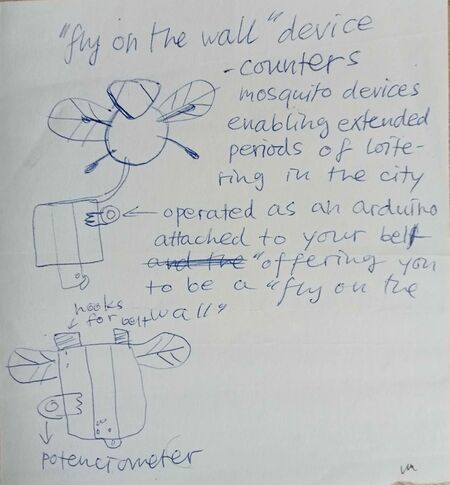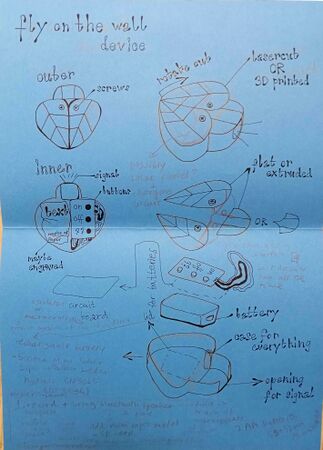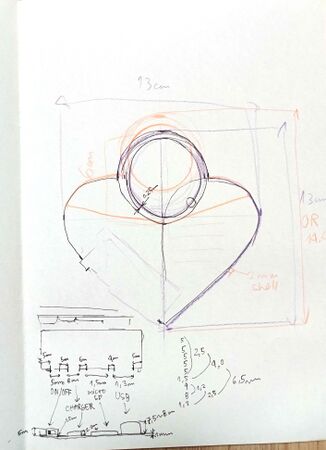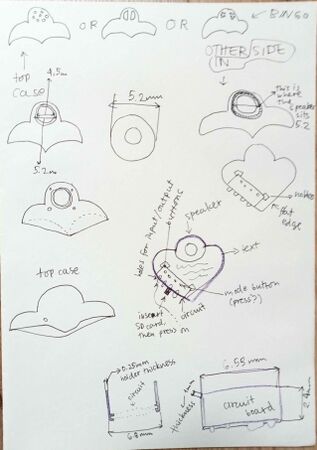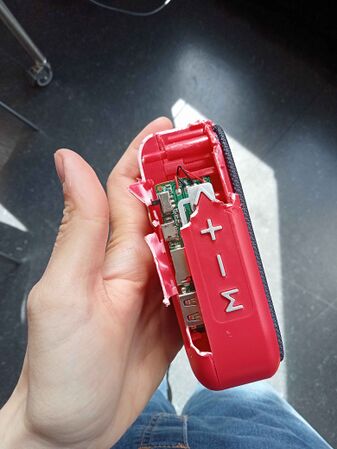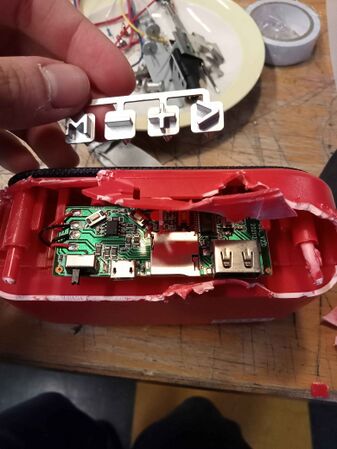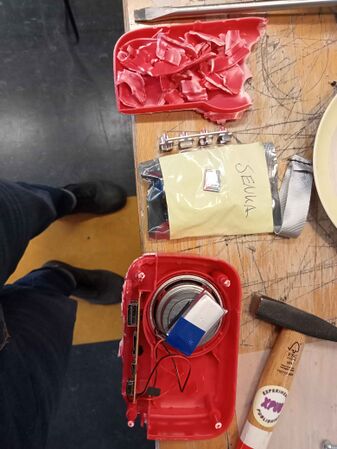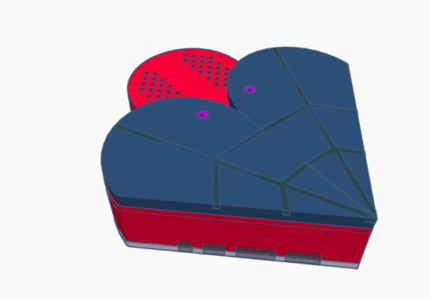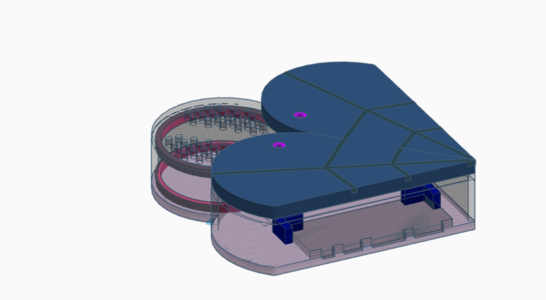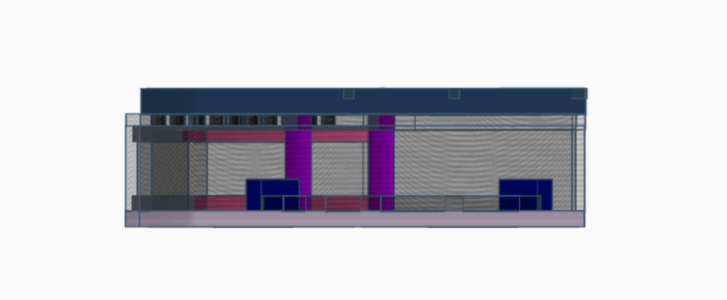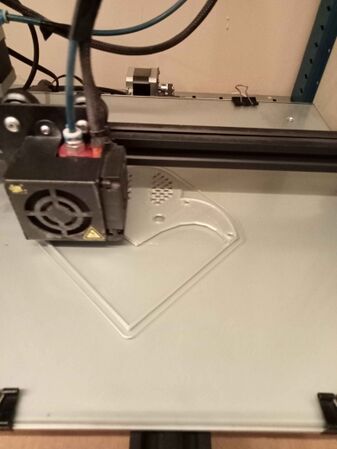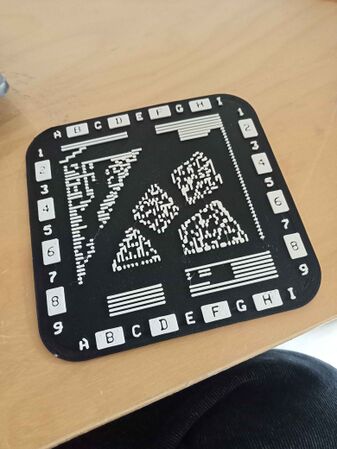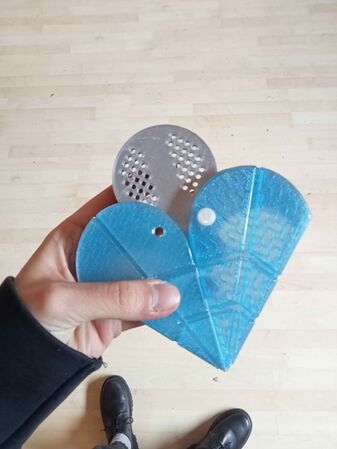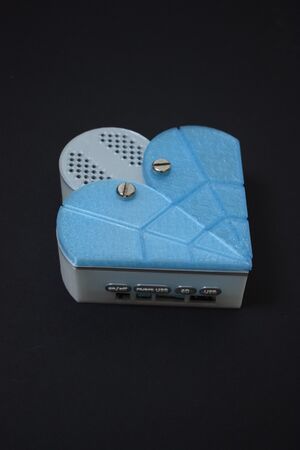User:Senka/special issue 3/Fly on the Wall: Difference between revisions
mNo edit summary |
No edit summary |
||
| (3 intermediate revisions by the same user not shown) | |||
| Line 1: | Line 1: | ||
==Description== | |||
This is a device built to counter mosquito devices and prolong possible periods of loitering. <br> | |||
Mosquito devices emit high frequencies and are installed by private companies and individuals to specifically target and drive away youth from hanging out. They can cause nausea, ear pain and overstimulation, and some activists have called it a 'sonic weapon'. They're frequently installed in liminal spaces, which are fruitful places for loitering and socializing. <br> | |||
The 'Fly on the Wall' device mimics how a mosquito works to cancel out its effects, and make room for youth to loiter without disruptions. <br> <br> | |||
Mosquito devices, in my opinion and experience, are just bad and unsafe. They impact young people the most, with the heaviest accent put on people with sensory processing issues or sensitivities this device is damaging. They're a technological fix to ward people away from claiming public space and loiter, replacing what could have been an in-person conversation of a neighbour asking people to not be too loud, or something of this kind. <br> | |||
These devices in Rotterdam can be found around residential areas as well as, liminal spaces between buildings, outside of museums, near parking lots, behind groceries stores and similar. <br> | |||
When we had a session with Angelikki about them, what stuck with me was her describing liminal spaces as a spaces of sociality. I really resonated with this description because I could recall my whole youth being spent outside of residential building, sitting on the staircase, in the parking lot of a mall and similar. | |||
==Evil Twin proposal== | |||
Original proposal: | |||
[[File:Evil Twin Fly on the Wall.jpg|450px|none|alt=Evil Twin Fly on the Wall proposal]] | |||
==Prototyping the 3D case and mechanism== | |||
<gallery mode=packed heights=300px style="text-align:left;"> | |||
File:Manual Fly on the wall.jpg|alt=Manual Fly on the wall|Manual Fly on the wall | |||
File:Measurements.jpg|alt=Refinement of exact measurements|Refinement of exact measurements | |||
File:Design and mechanism.jpg|alt=Fine-tuning design and mechanism|Fine-tuning design and mechanism | |||
</gallery> | |||
I was surprised to realize how difficult it is for me to sketch a design until I know everything about every component that might be connected and a part of the prototype.. | |||
==Repurposing an old speaker== | |||
As I was quite lost with where to start and how, I asked Joseph for some advice. He advised to get familiar with a second-hand bluetooth speaker and just print a different case for it. I broke it open and was quite happy to see and figure out how the inside of it works. A lot of the connection had to be resoldered and resoldered and resoldered, but that was a good way to get a bit more familiar with soldering. | |||
<gallery mode=packed heights=300px style="text-align:left;"> | <gallery mode=packed heights=300px style="text-align:left;"> | ||
File:Breaking up old speaker.jpg|alt=broken second hand bluetooth speaker|broken second-hand bluetooth speaker | File:Breaking up old speaker.jpg|alt=broken second hand bluetooth speaker|broken second-hand bluetooth speaker | ||
File:Broken second hand bluetooth speaker.jpg|alt=broken second hand bluetooth speaker|which I got on marktplaatz | File:Broken second hand bluetooth speaker.jpg|alt=broken second hand bluetooth speaker|which I got on marktplaatz | ||
File:Broken second hand bluetooth speaker-1.jpg|alt=broken second hand bluetooth speaker|and broke open with a hammer to get the parts | File:Broken second hand bluetooth speaker-1.jpg|alt=broken second hand bluetooth speaker|and broke open with a hammer to get the parts | ||
</gallery> | |||
==Audio== | |||
To attempt to make an anti-mosquito I needed to first record one, then phase and reverse the frequencies so they would cancel each other out. I went to record the mosquito with my phone, and almost fell off my bike because of how loudly it buzzes in the residential area in Coolhaven. <br> | |||
Doing this wasn't hard, but the real issue (that remained unresolved) is how would I do that with live frequencies, how would I predict with frequency would come next in order to phase and reverse it? <br> | |||
There wasn't a simple answer to this, but the possibility of a different approach altogether. Joseph suggest to look into making a remote that would turn them off, but I continued on this current path, now focusing on making the case.. | |||
==3D printing at .zip with Louisa== | ==3D printing at .zip with Louisa== | ||
Tinkercad was really nice to work with, I was surprised to see that a collaborative 3D tool of this quality was available for free. [https://www.tinkercad.com/things/3plKOrLVuWi-powerful-habbi-tumelo/edit] I worked on this link but now it is no longer available. | Tinkercad was really nice to work with, I was surprised to see that a collaborative 3D tool of this quality was available for free. [https://www.tinkercad.com/things/3plKOrLVuWi-powerful-habbi-tumelo/edit] I worked on this link but now it is no longer available. | ||
| Line 31: | Line 54: | ||
I was quite blessed to be able to work with .zip's filaments, as they have such a wide array of colours and some semi-transparent filaments. | I was quite blessed to be able to work with .zip's filaments, as they have such a wide array of colours and some semi-transparent filaments. | ||
* Why this name, | ==Some decisions== | ||
* Why this name: A lot of loitering I have experienced as letting time pass without a focus on productivity or getting things done, so the title 'A Fly on the Wall' seemed fitting. To be an observer, someone just absorbing the surroundings anonymously while at the same time taking up physical space in the city. | |||
* Why this design: I wanted the design to be cute, almost like a toy, so that if it actually worked, if security would stop you as a suspect, they would never even think that this device could be the cause of the mosquito not being audible anymore. The design resembles the fly and is portable an hand held, like a gadget you might need in an emergency. | |||
[[File:Fly_on_the_wall.jpg|thumb|finished prototype]] | |||
Latest revision as of 17:51, 25 September 2024
Description
This is a device built to counter mosquito devices and prolong possible periods of loitering.
Mosquito devices emit high frequencies and are installed by private companies and individuals to specifically target and drive away youth from hanging out. They can cause nausea, ear pain and overstimulation, and some activists have called it a 'sonic weapon'. They're frequently installed in liminal spaces, which are fruitful places for loitering and socializing.
The 'Fly on the Wall' device mimics how a mosquito works to cancel out its effects, and make room for youth to loiter without disruptions.
Mosquito devices, in my opinion and experience, are just bad and unsafe. They impact young people the most, with the heaviest accent put on people with sensory processing issues or sensitivities this device is damaging. They're a technological fix to ward people away from claiming public space and loiter, replacing what could have been an in-person conversation of a neighbour asking people to not be too loud, or something of this kind.
These devices in Rotterdam can be found around residential areas as well as, liminal spaces between buildings, outside of museums, near parking lots, behind groceries stores and similar.
When we had a session with Angelikki about them, what stuck with me was her describing liminal spaces as a spaces of sociality. I really resonated with this description because I could recall my whole youth being spent outside of residential building, sitting on the staircase, in the parking lot of a mall and similar.
Evil Twin proposal
Original proposal:
Prototyping the 3D case and mechanism
I was surprised to realize how difficult it is for me to sketch a design until I know everything about every component that might be connected and a part of the prototype..
Repurposing an old speaker
As I was quite lost with where to start and how, I asked Joseph for some advice. He advised to get familiar with a second-hand bluetooth speaker and just print a different case for it. I broke it open and was quite happy to see and figure out how the inside of it works. A lot of the connection had to be resoldered and resoldered and resoldered, but that was a good way to get a bit more familiar with soldering.
Audio
To attempt to make an anti-mosquito I needed to first record one, then phase and reverse the frequencies so they would cancel each other out. I went to record the mosquito with my phone, and almost fell off my bike because of how loudly it buzzes in the residential area in Coolhaven.
Doing this wasn't hard, but the real issue (that remained unresolved) is how would I do that with live frequencies, how would I predict with frequency would come next in order to phase and reverse it?
There wasn't a simple answer to this, but the possibility of a different approach altogether. Joseph suggest to look into making a remote that would turn them off, but I continued on this current path, now focusing on making the case..
3D printing at .zip with Louisa
Tinkercad was really nice to work with, I was surprised to see that a collaborative 3D tool of this quality was available for free. [1] I worked on this link but now it is no longer available.
Louisa's guidance was really helpful and motivating for doing this project to begin with, but also just for the execution.
It was super useful to know that you can 3D print nuts and bolts and find already made models that tinkercad offers. Though, in my case the printed bolt wasn't strong enough, so I ended up screwing in a metal screw that broke the connecting structure which was supposed to keep it together and I found a way to fix it with a metal nut that didn't rely on the 3D printed element.
I was quite blessed to be able to work with .zip's filaments, as they have such a wide array of colours and some semi-transparent filaments.
Some decisions
- Why this name: A lot of loitering I have experienced as letting time pass without a focus on productivity or getting things done, so the title 'A Fly on the Wall' seemed fitting. To be an observer, someone just absorbing the surroundings anonymously while at the same time taking up physical space in the city.
- Why this design: I wanted the design to be cute, almost like a toy, so that if it actually worked, if security would stop you as a suspect, they would never even think that this device could be the cause of the mosquito not being audible anymore. The design resembles the fly and is portable an hand held, like a gadget you might need in an emergency.

